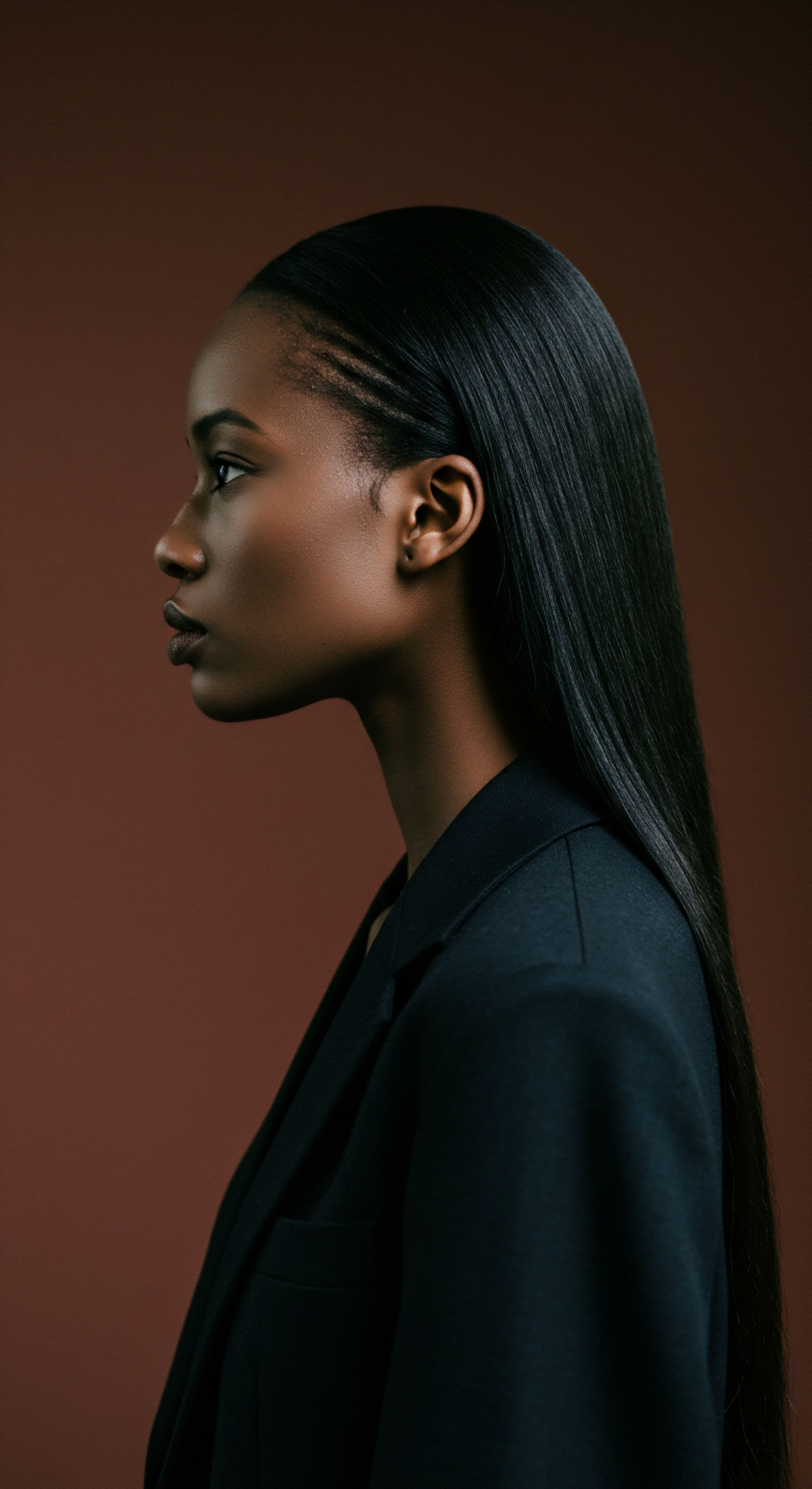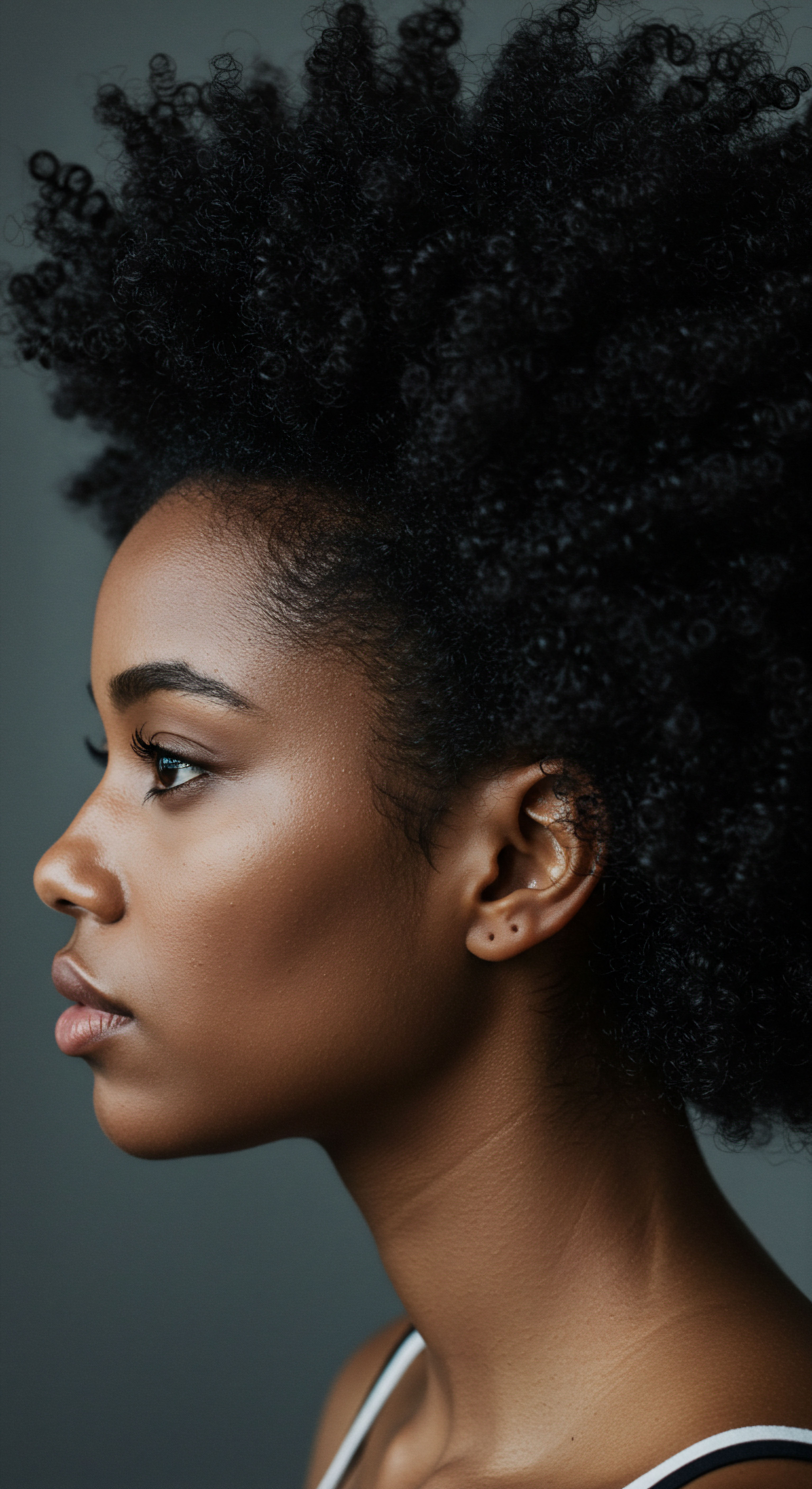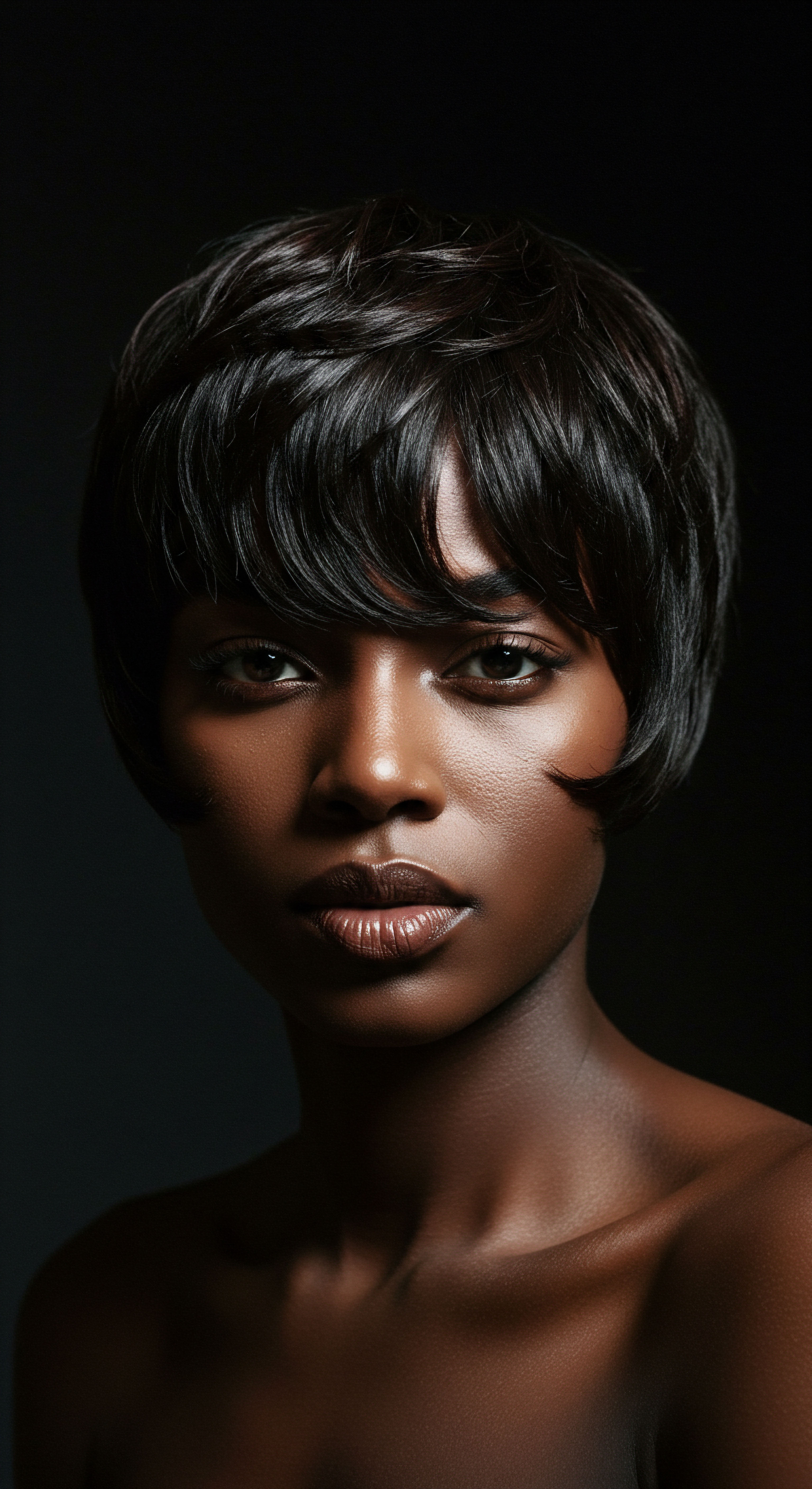
Roots
A gentle whisper carried on the wind, a quiet observation that perhaps we have overlooked something fundamental in our bustling school halls. We often consider uniforms, textbooks, and curricula as the pillars of education, yet there is a deeply personal, often unspoken, element that shapes a student’s journey ❉ their hair. The policies governing this seemingly simple aspect of appearance ripple through identity, influencing self-perception and belonging in profound ways. To truly grasp the impact of these regulations, we must first look to the very origins of our strands, understanding that hair is far more than mere adornment; it is a profound marker of self, culture, and heritage.

The Silent Language of Hair
Every curl, coil, and wave carries a story, a legacy. For many, particularly those of Black and mixed-race heritage, hair is an undeniable extension of their cultural identity, a visible connection to ancestry and community. It is a canvas for expression, a testament to resilience, and often, a symbol of resistance.
When school policies dictate how these natural expressions must be contained or altered, they touch upon something far deeper than mere aesthetics. They challenge a student’s sense of authenticity, questioning the very validity of their inherent being.

Hair as Cultural Marker
Historically, hairstyles in many cultures served as visual cues, communicating age, marital status, tribal affiliation, and even social standing. For people of African descent, hair has held particular significance, often serving as a link to ancestral lands and traditions, even through the brutalities of forced displacement. The intricate braiding patterns, the voluminous afros, the enduring locs—each style speaks volumes without uttering a single sound. These are not merely fashion choices; they are living traditions, passed down through generations, embodying collective memory and pride.
Hair, especially for those of Black and mixed-race heritage, is a profound cultural marker, carrying stories and legacies that extend far beyond simple aesthetics.
When a school policy, perhaps inadvertently, restricts these styles, it sends a message that a part of a student’s cultural heritage is unwelcome or inappropriate. This can lead to a painful disconnect, forcing young individuals to choose between conforming to an external standard and honoring their inner sense of self. The pressure to straighten, cut, or otherwise modify natural hair to fit Eurocentric beauty standards has a long and troubling history, rooted in systemic biases that have persisted through generations. This historical context illuminates why current hair policies in educational settings can feel like echoes of past oppressions, impacting students’ psychological well-being and their ability to thrive academically and socially.

Unseen Burdens on Student Psyche
The weight of hair policies extends beyond physical appearance, settling deep within a student’s psychological landscape. When rules are perceived as discriminatory, they can chip away at self-esteem and foster a sense of otherness. This internal conflict can be particularly acute for young people who are still solidifying their identity. The daily negotiation of how to present oneself, balancing personal expression with institutional expectations, can become a source of ongoing stress.
A student who feels their natural hair is deemed “unprofessional” or “distracting” may internalize these negative stereotypes, leading to feelings of inadequacy. This can manifest as anxiety, reduced participation in class, or even avoidance of school altogether. The academic environment, ideally a place of safety and growth, transforms into a space where one’s very being is under scrutiny.
- Self-Perception ❉ Students may begin to view their natural hair, and by extension, themselves, as problematic or undesirable.
- Belonging ❉ Policies that exclude culturally significant hairstyles can diminish a student’s sense of connection to their school community.
- Authenticity ❉ The pressure to alter one’s hair can compromise a student’s ability to express their true self, fostering a feeling of inauthenticity.
These unseen burdens are often borne silently, yet their cumulative effect can be significant, influencing not only a student’s academic journey but also their broader personal development. Understanding the roots of these policies, both historical and psychological, becomes the first step toward cultivating truly inclusive educational environments where every student feels seen, valued, and free to be themselves.

Ritual
Stepping from the foundational understanding of hair’s deep significance, we now turn our attention to the daily practices, the intimate rituals that shape a student’s relationship with their strands. For many, hair care is a meticulous, often time-consuming, endeavor—a ritualistic dance of cleansing, nourishing, and styling. When school policies intervene in this personal space, they do more than simply regulate appearance; they disrupt these routines, forcing students to adapt, conform, or even abandon practices integral to their hair’s health and their personal comfort. The choices made, or denied, in the realm of hair care have tangible impacts on a student’s well-being and their ability to fully engage in their educational experience.

The Daily Dance of Hair Care
Consider the morning routine of a student with highly textured hair. It might involve a careful detangling process, the application of specific leave-in conditioners and stylers, and then a deliberate styling technique—be it braiding, twisting, or defining curls. These steps are not arbitrary; they are responses to the unique needs of their hair, designed to maintain moisture, prevent breakage, and achieve a desired style that is both healthy and culturally affirming.

Practical Challenges of Restrictive Rules
When school policies mandate certain lengths or styles, or prohibit protective styles like locs or braids, they create immediate practical challenges. A student might find their carefully crafted routine, designed to protect their hair, suddenly deemed non-compliant. This can lead to:
- Increased Time Investment ❉ Students may need to spend more time manipulating their hair into less protective or more damaging styles to meet school standards.
- Hair Health Compromises ❉ Frequent chemical straightening or excessive heat styling, often pursued to conform, can lead to physical damage, including breakage and hair loss.
- Financial Strain ❉ Maintaining hairstyles that conform to Eurocentric standards, such as chemical relaxers or frequent salon visits for straightening, can impose a significant financial burden on families.
These practical burdens are not merely inconveniences; they can detract from a student’s focus on academics, adding a layer of stress to their daily lives. The time spent battling their hair or worrying about compliance is time taken away from homework, rest, or extracurricular activities.

What are the Real-World Consequences of Hair Policies?
The implications of restrictive hair policies extend into a student’s mental and emotional landscape, shaping their academic journey and their sense of belonging within the school community. A compelling illustration of this can be seen in the disproportionate disciplinary actions faced by Black students. A 2024 report by the Education Law Center, drawing on data from the American Civil Liberties Union of Texas, revealed that Black students received 31% of documented dress code disciplinary instances, despite making up only 12% of the surveyed student population in those districts.
White students, comprising 25% of the population, accounted for only 13% of these instances. This stark disparity highlights a systemic bias, where policies, often framed as promoting “uniformity” or “discipline,” are applied in ways that penalize culturally significant Black hairstyles, such as locs, braids, and Afros.
Discriminatory hair policies can lead to disproportionate disciplinary actions, affecting a student’s academic progress and sense of security.
Such disciplinary actions, ranging from in-school suspension to removal from classrooms, directly disrupt a student’s learning, causing them to miss valuable instructional time. The psychological impact is equally significant. When students are repeatedly told that their natural hair is “unprofessional” or “unruly,” they may internalize these negative messages, leading to feelings of shame, anxiety, and a diminished sense of self-worth. This constant negotiation of appearance and identity can undermine their confidence and ability to thrive in academic spaces.
The narrative of Darryl George, a Texas high school student who was kept out of his classroom for months due to his locs, underscores the severity of these consequences, even in states where the CROWN Act is in place. His experience, and that of others, illustrates how the pursuit of a specific hair aesthetic, rooted in cultural heritage, can result in educational exclusion and emotional distress.
The pressure to conform often leads students to modify their natural hair, sometimes through methods that are physically damaging, such as chemical relaxers or excessive heat styling. This not only compromises hair health but also forces a student to suppress a visible aspect of their identity. The ritual of hair care, once a personal expression, transforms into an act of compliance, stripped of its deeper meaning.
| Aspect of Impact Academic Disruption |
| Description of Effect Students facing disciplinary action for hair policies miss instructional time, affecting grades and overall learning. |
| Aspect of Impact Psychological Harm |
| Description of Effect Negative self-perception, anxiety, and diminished self-esteem result from internalizing messages that natural hair is unacceptable. |
| Aspect of Impact Cultural Disconnect |
| Description of Effect Forced conformity to Eurocentric standards can lead to a sense of alienation from one's cultural heritage. |
| Aspect of Impact Physical Hair Damage |
| Description of Effect Pressure to chemically straighten or excessively heat style hair to conform can cause long-term damage and loss. |
| Aspect of Impact These consequences highlight the urgent need for inclusive policies that protect student identity. |
These real-world consequences underscore that hair policies are not neutral; they are deeply intertwined with issues of race, culture, and personal dignity. The daily rituals of hair care become a battleground for identity, where the stakes are a student’s self-worth and their fundamental right to an equitable education.

Relay
As we consider the daily rituals, the personal efforts poured into hair care, we must now turn our gaze to the broader societal currents that carry and amplify the effects of hair policies. This deeper look reveals that the classroom is not an isolated bubble; it is a microcosm reflecting larger cultural biases and historical patterns. Understanding how these policies operate within a complex interplay of biological, psychological, social, and cultural factors allows us to grasp the full measure of their impact on student identity. This is where the nuanced conversation truly begins, moving beyond surface-level discussions to confront the profound implications of what it means to belong, to be seen, and to thrive.

How Do Hair Policies Echo Historical Oppression?
The origins of discriminatory hair policies in schools are not new; they are deeply rooted in historical efforts to control and assimilate marginalized groups, particularly those of African descent. During the transatlantic slave trade, the shaving of enslaved Africans’ hair upon arrival was a deliberate act to strip them of identity and culture, imposing European standards of appearance. This historical legacy continues to manifest in modern school grooming codes that often reflect Eurocentric beauty norms, deeming natural Black hairstyles as “unprofessional” or “unruly.”
This historical context is crucial for understanding why current policies, even those seemingly neutral, can inflict what the Association of Black Psychologists terms “esthetic trauma.” When a student is disciplined for wearing locs, braids, or an afro, they are not just violating a dress code; they are confronting a system that, consciously or unconsciously, perpetuates historical biases against their natural being. This perpetuation of bias can lead to internalized racism and negative self-image, contributing to chronic stress in academic settings.

The Psychological Toll of Unseen Bias
The psychological burden placed upon students by discriminatory hair policies is multifaceted. Beyond the immediate disciplinary actions, there is the subtle yet pervasive impact of microaggressions—indirect, subtle, or unintentional expressions of prejudice. These can range from unwanted touching of hair to dismissive comments, all contributing to a hostile environment. Research indicates that such experiences are a significant source of trauma and identity negotiation within school contexts.
A 2021 study by Dove CROWN Research for Girls, in collaboration with JOY Collective, illuminated the early onset and pervasive nature of this discrimination:
- Early Exposure ❉ Black girls as young as five years old experience hair discrimination, as reported by their parents.
- Adolescent Impact ❉ 86% of Black teenagers began experiencing discrimination based on their hair by the age of twelve.
- Internalized Norms ❉ 81% of Black children in majority-white schools reported wishing their hair was straight.
These statistics paint a stark picture of how deeply ingrained Eurocentric beauty standards are within educational environments, shaping the self-perception of young individuals from a very tender age. The desire to conform, even at the cost of one’s natural self, underscores the immense pressure students face.

What Role Does Legislation Play in Shaping Identity Affirmation?
In response to widespread hair discrimination, legislative efforts like the CROWN Act have emerged as vital tools for identity affirmation. The CROWN Act, standing for “Creating a Respectful and Open World for Natural Hair,” prohibits discrimination based on hair texture and protective hairstyles such as locs, braids, twists, and Afros. Its passage in numerous states signifies a growing recognition that hair discrimination is a form of racial discrimination.
The CROWN Act stands as a legislative shield, working to dismantle hair discrimination and affirm the right to natural hair expression in educational settings.
While the CROWN Act provides a legal framework, its implementation and interpretation remain critical. The case of Darryl George in Texas, where a student faced ongoing suspension despite the state’s adoption of the CROWN Act, highlights the ongoing struggle. This situation reveals that legal protections, while indispensable, are only one part of the solution. True identity affirmation requires a deeper shift in institutional culture and individual mindsets.
The presence of such legislation sends a powerful message to students ❉ their natural hair is valid, worthy of respect, and protected. This can bolster self-esteem and encourage authentic self-expression. For students who previously felt compelled to alter their hair to avoid disciplinary action or social exclusion, the CROWN Act offers a newfound sense of security and validation. It allows them to wear their hair in ways that align with their cultural heritage and personal comfort, without fear of reprisal.
| Year 2019 |
| Event or Legislation California passes the first CROWN Act, prohibiting race-based hair discrimination. |
| Year 2020-Present |
| Event or Legislation Numerous states and localities follow California's lead, enacting their own versions of the CROWN Act. |
| Year Ongoing |
| Event or Legislation Legal challenges and advocacy continue to push for broader adoption and robust enforcement of anti-discrimination laws. |
| Year These legislative steps are crucial in the ongoing fight for equitable hair policies. |
Ultimately, the relay of influence from historical biases to current policies, and then to legislative responses, paints a comprehensive picture of how deeply hair policies affect student identity. It underscores the ongoing need for vigilance, education, and cultural competence within educational institutions to ensure that every student can learn and grow in an environment that truly respects and celebrates who they are.

Reflection
The journey through the intricate world of hair policies and student identity reveals a landscape far more complex than a simple rulebook. It is a terrain where personal history, cultural legacy, and societal expectations converge, shaping the very core of who a young person believes themselves to be. We have seen how a seemingly minor regulation can echo generations of bias, how a daily ritual becomes an act of quiet defiance or reluctant conformity, and how the pursuit of academic success can become intertwined with the burden of appearance.
As we conclude this exploration, a gentle invitation lingers ❉ to look beyond the surface, to perceive the silent narratives held within each strand, and to recognize the profound courage it takes for a student to stand authentically in their own being. The conversation surrounding hair in schools is not merely about rules; it is about human dignity, equity, and the unwavering right of every student to learn, grow, and shine, wholly and unapologetically. It is a call to foster environments where self-acceptance is not just permitted, but celebrated, allowing every individual to truly flourish.

References
- Duggins-Clay, P. Lyons, M. & Ryan, T. (2025). Confronting Hair Discrimination in Schools – A Call to Honor Black History by Protecting Student Rights. IDRA Newsletter.
- Kempf, K. et al. (2024). The Prevalence and Impact of Hair Discrimination. American Civil Liberties Union of Texas.
- Joseph-Salisbury, R. & Connelly, L. (2018). Black Hair and the Politics of School Dress Codes. Runnymede Trust.
- Griffiths, S. & Haughton, M. (2021). UK Black hair matters ❉ A thematic analysis exploring Afro-Caribbean women’s hair as representations of the socially constructed knowledge of identity and identity threats. Psychology of Women & Equalities Review, 4(2).
- Edwards, T. K. (2020). From the Editorial Board ❉ Tangled Discrimination in Schools ❉ Binding Hair to Control Student Identity. High School Journal, 103(3).
- Henderson, A. (2022). Beyond the roots ❉ exploring the link between black hair and mental health. TRIYBE Research and Community Dialogues.
- Byrd, A. & Tharps, L. (2014). Hair Story ❉ Untangling the Roots of Black Hair in America. St. Martin’s Press.
- Dove CROWN Research for Girls. (2021). Hair Discrimination Study (in collaboration with JOY Collective).
- Lento Law Firm. (2023). Hairstyle Discrimination in Schools.
- Adler, S. & Goodman, A. (2019). The CROWN Act ❉ A Legal and Social Movement. New York Law Journal.
- George, D. (2024). Darryl George’s case and the CROWN Act. Economic Policy Institute.
- Robinson, C. (2011). The Psychology of Black Hair ❉ A Cultural Perspective. Palgrave Macmillan.